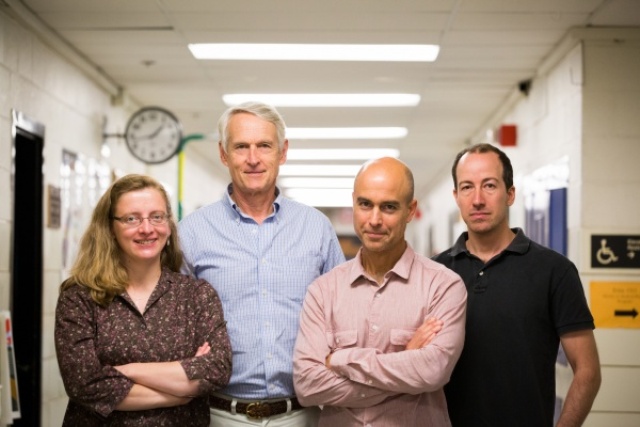Apr 13 2015
After a two-year hiatus, the Large Hadron Collider at the European Organization for Nuclear Research, or CERN, is gearing up for its second run. The LHC enabled the 2012 discovery of the Higgs boson, which gives mass to all particles, but the world’s most complicated scientific apparatus is far from finished
 Faculty on Penn's ATLAS team Evelyn Thomson, Brig Williams, Joseph Kroll and Elliot Lipeles. (Photo: Scott Spitzer)
Faculty on Penn's ATLAS team Evelyn Thomson, Brig Williams, Joseph Kroll and Elliot Lipeles. (Photo: Scott Spitzer)
Four University of Pennsylvania professors, along with their students and post-docs who were a vital part of the Higgs boson breakthrough at CERN, are now looking forward to discovering new physics in this second, higher energy run of the LHC, which began on April 5.
The LHC works by accelerating two bunches of protons in opposite directions on a 17-mile-long circular track. When these protons collide at very high speeds, the collisions can produce new, previously unobserved particles, which break apart, or decay, into smaller particles.
These high-energy collisions are thought to mimic the ones that happened during the origin of the universe, the big bang. Detectors track the shrapnel that passes through them after these collisions, and CERN’s scientists work backwards to reconstruct what happened in these highly energetic events
That painstaking process is in the service of answering some of the most fundamental questions about the makeup of the universe, and it remains a valuable opportunity for training the next generation of Penn particle physicists.
The Penn contingent consists of professors Brig Williams, Joseph Kroll, Evelyn Thomson and Elliot Lipeles, all based in the Department of Physics and Astronomy in Penn’s School of Arts & Sciences, and a team of four postdoctoral fellows, 12 graduate students and technical staff.
From the beginning, Penn has been an integral part of the ATLAS project, one of the four main detectors, providing a clear path for interested students and post-docs to get involved.
Penn has a continued interest in sending students to work at CERN, says Alex Tuna, a fifth-year graduate student working there under Williams.
“Our professors understand that it’s important for students to have this opportunity,” he says. “If you want to have an impact in the collaboration, you have to have people there working on the detector.”
Tuna has been working and living at CERN for two and a half years; he moved to Switzerland once he was finished taking classes in his second year of graduate school. This is a common trajectory for Penn graduate students interested in particle physics. Classmate Kurt Brendlinger is also a fifth-year graduate student who is working under Kroll.
Tuna and Brendlinger each work with different groups at CERN, focusing on different particles and decay routes.
“Each person has a couple of projects that they work on,” depending on their interests, says Brendlinger. With so many varied interests coming together, “it’s like a think tank.”
In one of his research tracks, Brendlinger works with a group that focuses on detecting the decay of the Higgs particle to four electrons or muons with Penn postdoctoral fellow Sarah Heim. Heim also works with Tuna on the TRT detector, a component of ATLAS that records tracks of charged particles. A large part of the electronics of the TRT detector was developed at Penn.
“It’s a very flexible environment,” says Heim, since a student can work with any of the professors if interests align. But whatever they do, working with the LHC demands a hefty commitment.
“Twelve–14 hour days are not unusual, ” says Tuna. “Weekends, too.”
Getting the proton beams up to speed takes tremendous time and energy, so, when the detector is gathering data, scientists must take shifts to monitor the control center 24 hours per day. And, if there’s a problem, someone has to come fix it immediately.
“I’ve been called at 2 a.m. before,” says Heim. “This is one of the challenging sides of the job; it’s not something you leave when you close the office door.”
Daily meetings are also an integral part of working at CERN. Heim says working in such a collaborative environment creates the need for everyone to communicate regularly. It is also a perk to get to work with other experts in the field.
“Whenever you have a question, there will be an expert somewhere around on that topic,” says Heim.
The past two years at the LHC have been focused on analyzing the data collected from the previous run and getting the detector ready for its run in March. The difference with this run is the collisions will happen at a higher energy. This higher energy is crucial to finding new particles.
“In 2012, the center of mass energy was 8 TeV,” or tera-electron volts. “This year the LHC will collide protons with 13 TeV,” says Heim. “The higher the energy of the particles that you collide, the heavier the particles you can produce, and so the idea is that maybe we can produce particles that are so heavy we couldn’t see them in 2012. We can increase our search range dramatically.”
Finding heavier particles could shed light on some of the unanswered questions in physics.
“What is the origin of dark matter? Does super symmetry exist? We haven’t probed these topics at 13 TeV yet,” says Tuna. “We have a very open mind about what kind of new physics could be out there.”